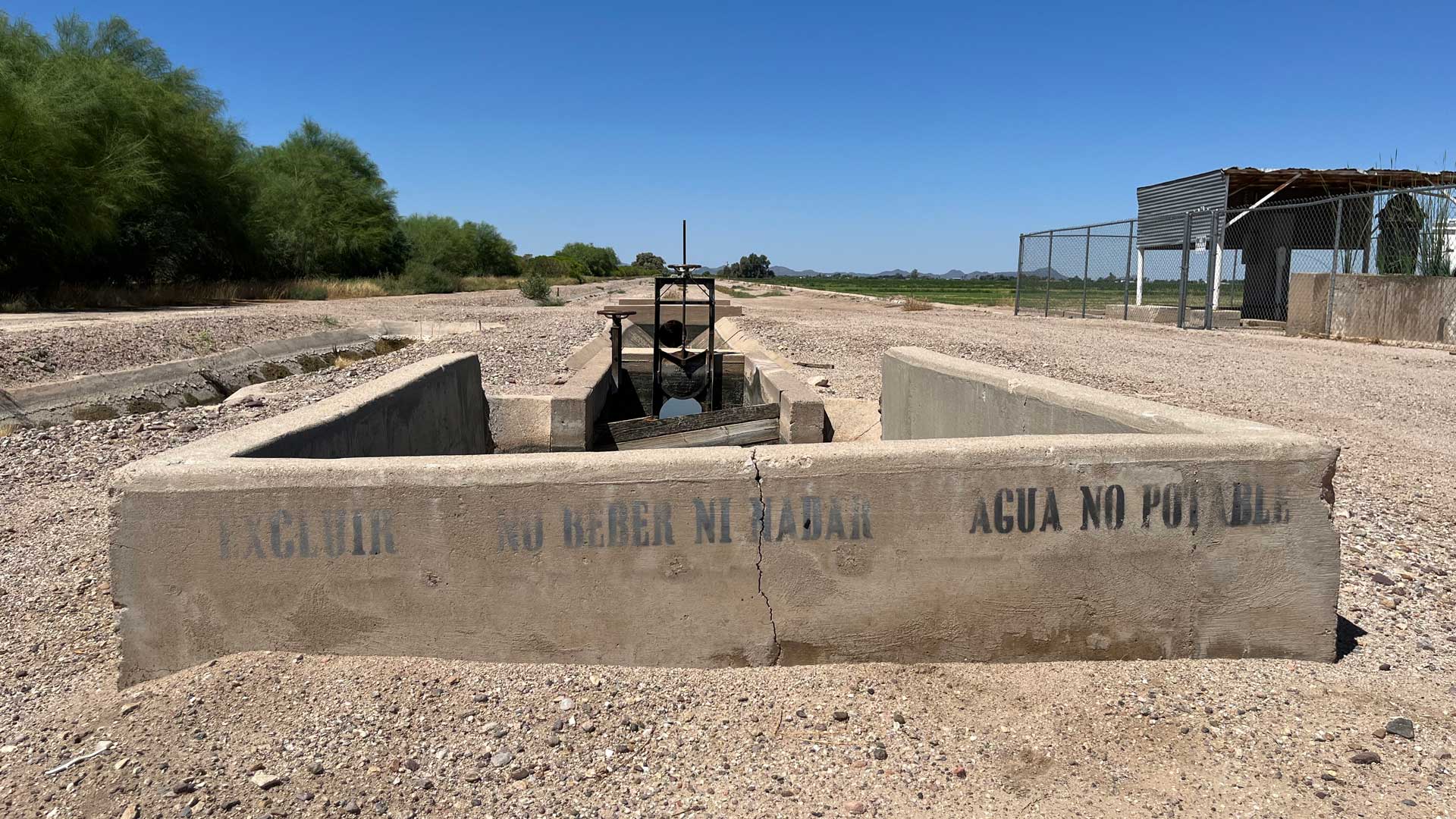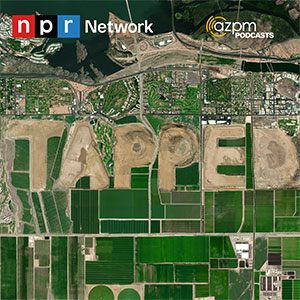 An alfalfa field in Marana, AZ bordered by I-10. September 2023
An alfalfa field in Marana, AZ bordered by I-10. September 2023
Season 2, Ep. 3: Why is alfalfa one of Arizona's biggest crops?

Tapped begins a mini-series looking at the state's traditional economic drivers and water, what are traditionally known as the 5 Cs of Arizona. Since three of those five are agricultural products, we start by talking about farming and ranching.
Episode transcription
(Distant highway audio)
ZZ: If you’ve ever driven by a farm field in the desert, you probably have wondered why are they growing crops here? Dr. Jeff Silvertooth is an Agronomy and Soil Science professor at the University of Arizona. Standing with us in one of those fields in Marana, Arizona he says it actually…from an agricultural point of view it makes sense.
JS: This is part of the Santa Cruz River Valley for one, on the edge of it. And actually, I-10 borders us on the east before we come into what we call the Uplands, which are not favorable soil. So these are beautiful alluvial soils that we commonly utilize for agriculture in Arizona. And this is a great example of it, those alluvial soils deposited by waters from the Santa Cruz as if was flooding over really thousands and millions of years, eons of time.
The soils out here, they're geologically young, typical of Arizona alluvial soils. They're highly fertile and highly productive if we provide them with adequate water, and that's why we irrigate everything here in the desert. But it's a little bit of a misnomer to think, 'Oh, these soils that we deal with out here are just rock and sand and we don't have good soil. We do if we manage it properly."
CC: Manage it properly…that is the rub…how do you get water, and at what cost, to fields like this one?
(Audio fades, theme music starts)
ZZ: This is Tapped, a podcast about water. I'm ZZ.
CC: And I'm CC. Arizona’s economy is traditionally based on the Five-Cs…cotton, citrus, cattle, climate, and copper… all are heavily tied to the availability of water in a state that is in the midst of a historic drought.
ZZ: So we’re going to spend the next few episodes looking at those relationships. Up first…the three agricultural components…cotton, citrus, and cattle.
(theme ends)
CC: People living in southern Arizona are familiar with the Central Arizona Project…the CAP…which brings Colorado River water to Phoenix and Tucson through a series of open canals. Famers in Marana get SOME water from the CAP…but it is not the primary source for agriculture here…
JS: There's groundwater that a farmer can have if they have some wells, that can come through on groundwater. There's irrigation water coming down here that's reclaimed water from the City of Tucson, and so that comes into this Irrigation District not far from where we are.
 An irrigation ditch using reclaimed water in Marana, AZ. September 2023
An irrigation ditch using reclaimed water in Marana, AZ. September 2023
CC: And we are standing in the field of one of those crops…
JS: "Alfalfa has been unfairly demonized in my view. One of the reasons it does use more water is these alfalfa fields are here year-round. They're perennial. They are perennial plants so I think this field right here, I was visiting with the farmer this morning, is about 3 years old."
You'll see we have this field set up so it's in what we call borders, like big flat sections, and these sections get flooded. Now people criticize the flooding but we can be efficient with that if we manage it well. They're pretty close to dead level and they can manage this irrigation water with time management, so they put on just the right amount of what they need. So we can do a good job and we leach salts. Other crops that are more like row crops have a tendency to pull some salts up to the surface, and an alfalfa crop helps us move those salts down through the profile, which is a constant issue of management in desert agriculture, not just in Arizona but all over the world.
CC: Getting rid of that buildup of salt and minerals has plagued farmers as long as people have been farming in the areas we now call Pima and Pinal counties Arizona.
JS: So you can go 60 miles north of here to Casa Grande National Monument, and there's– we don't know for sure, they didn't leave behind written record–but based upon all available evidence, archaeological and anthropological, it appears that one of the things that may have happened was increasing salinization of their soils.
ZZ: But plenty of people still see flood irrigation as wasteful of water. Jeff says some of that is due to people who are not in the agricultural industry not understanding what they are seeing as they drive by a field.
JS: It's like Dwight Eisenhower, I think it was in 1956, he made the statement that farming looks mighty easy when your plow is a pencil and you're a thousand miles from the cornfield. Well, that thought can extend over to this idea, people drive by look at fields being flooded, and think it's got to be horribly inefficient. At first glance, I can see how a person could think that. But in reality, these farmers, they don't want to waste water. It's the most expensive input they have and they know we need it to survive.
Pretty much now all fields are dead level or pretty close, a small degree of slope perhaps, but pretty close to dead level. And that means you can control the water distribution from the head where the water is introduced to the tail and from side to side. Otherwise, if you think about it, it's like having an unlevel pool table.
ZZ (field audio): When did we cross the line from bad irrigation practices that used too much water to these ones that are much more efficient?
JS: When water started costing more. I would say I've been here almost 40 years. I've been at U of A working as a hydro-soil scientist in various capacities for this my 37th season here. And things have rapidly improved over that time and primarily I saw that happening when the water prices were increasing, becoming more difficult. And that's a major cost with these irrigated production systems, the labor, the water pumping, delivering water, managing the water. So it becomes imperative to be more efficient with that resource you have.
CC: Jeff spent much of his career as an agricultural extension officer…that means he worked with the agriculture sector to help them improve what they are doing. That role now belongs to Dr. Ed Martin, the Associate Vice President and Director of the Arizona Cooperative Extension System. Martin says he has seen the change in technology over time.
EM: When I came in '92, just about everybody was flood irrigating. They have the canals and open up the ditches and just flood the land and let the water and gravity take its course. And that's how they would irrigate their crops. You're seeing a lot more people switching over to drip irrigation, which is a higher-efficiency system. Even the center pivots, some of the sprinkler systems are higher efficiency systems.
CC: The extension is trying to find ways to help with water and crop management.
EM: We're looking at the different types of monitors for the soil, looking at the water holding capacity and do we really need to add water or can we wait one more day before we irrigate and maybe take advantage of the monsoon rains if they ever hit for us, at least up in the Central Valley area? So technology is really where we've been doing a lot of our work lately.
ZZ: Farming is often on tight margins so moving to a more technologically advanced and more efficient system which could save money on irrigation also comes with a cost..
EM: For most growers though, you're right, it's really hard and the best thing that they can do is maybe grow higher value crops. With the drip systems they get more money per acre, but what they're facing right now is either do that or don't farm at all because they simply don't have enough water.
You know, many of our growers now–as you can imagine in a state that's growing as fast as we are with homes–a lot of them are renting the land and so for them to actually invest in a system that they might not be using in 5 or 10 years is very difficult.
ZZ: You might be surprised to learn that most farmland…at least in the area we are talking about is rented. And like Ed said would you sink money into improving a house you are renting? Heading back out to that alfalfa field in Marana, Jeff says that is the case here.
JS: Most of this land around the Marana area right along I-10 sold back in the 1990s, and we had a big boom and with the big boom a lot of developers came in there, saw this whole corridor between Phoenix and Tucson as having growth potential. A lot of that land was bought up at the time, the farmer sold the land and then they leased it back from the developers. And developers are now coming in and saying it's economically favorable to us to expand this development
ZZ: The housing development just south of where we are is called Gladden Farms, named after the farming family that sold it to the developer.
GF: So without water, you don't have agriculture here.
CC: That’s Dr. George Frisvold the Bartley P. Cardon Chair of Agribusiness Economics and Policy Extension Specialist.
GF: And what a lot of people look at is water applied per acre, which isn't really that useful of a metric. People use it because it's easy to record and measure, this amount of water was put on these many acres of the crop. But economically what's more important is how much dollar amount you get per acre foot of water.
The stuff that you think of being grown in Yuma in the winter time. If you look at value of output per acre foot of water, the veggie crops, the winter lettuce, the broccoli, the cauliflower, the spinach, all the leafy greens, those things are just really really super high value. And then if you look let's say at a county level, it's like how much dollar of crop output are you getting per acre foot of water? It's like Yuma way ahead of the rest of the Colorado Basin.
CC: Which brings us back to agricultural water enemy number one in the public eye…alfalfa
GF: Why are we growing alfalfa in the west? We're growing alfalfa in the west because we consume milk in the west and fresh dairy products are bulky. So historically they haven't been shipped great distances. So everybody in the Phoenix Metro Area and the Tucson Metro Area, a lot of their dairy products are coming locally. Like a lot of dairy operations between them in Pinal County and other parts of central Arizona.
We keep hearing that alfalfa is public enemy number one now…why?
TV audio: With the Southwest in the middle of a decades-long mega drought states are facing the biggest water crisis in generations. Well, in tonight's Eye on America, we head back to Arizona where earlier this year, we reported on foreign-owned farms that are draining the state's water supply.
ZZ: That's CBS Evening News reporting on Saudi Arabia exporting Arizona water in the form of alfalfa grown here for its cattle back home.
TV audio: This was your well? This was my well. And now you've got? Nothing but dust. Arizona Cattle Rancher Brad Mead says his well went dry. You can toss a rock in, and it's gone (clank, clank, clank).
ZZ: But Saudi Arabia is not the only foreign country involved in agriculture in Arizona. According to the US Department of Agriculture database…between 2016 and 2020…the most recent year in the database…27 foreign-owned companies owned 1.5 million acres of agricultural land in Arizona.
CC: The leader was Switzerland…owning more than 440,000 acres. Most of that was in Maricopa County…home to Phoenix.
Mexico was next at close to 260,000 acres. Much of that was owned by Mexican mining companies which were leasing the land out for grazing. Saudi Arabia owned 442 acres during that time frame.
ZZ: When it comes to alfalfa in Arizona…the USDA reports in 2022 that 260,000 acres of alfalfa hay were harvested in the state. In comparison…all agricultural crops totaled 1.2 million acres…making alfalfa hay by far the largest single crop in the state by acreage.
(audio fades in)
CC: Back in Marana, Jeff Silvertooth says there is a benefit to growing alfalfa.
JS: They also have the flexibility of taking this crop if the markets aren't good and feeding it to cattle themselves. We say we have two ways of selling alfalfa: you can sell it on the open market or on the hoof. And there's a good market for beef right now, so that's another one of the advantages.
CC: Again according to the USDA, as of January 2023 there were at least one million head of cattle in Arizona. Whether it is alfalfa hay they eat or the water they drink, cattle ranching is water dependent. Agribusiness economist George Frisvold says geography plays a role in where all of those crops are located…
GF: USDA does these little dot maps, That's like so many cows and so many alfalfa acres, and if you look at oh where are the cows? Huh, the cows aren't very far from where the people are. It's like where's the Alfalfa? The alfalfa isn't very far from the cows because alfalfa is bulky and hard to move around. So the alfalfa tends to be where the cows are. The cows tend to be where the people are and the people like fresh dairy products. So alfalfa is really, it's the local food of your local food.
CC: And food consumption is tied to water consumption…
GF: We like our local foods, but if you're going to have local foods, you're going to have local water use. We could import our food from someplace else and the water would come from there, but we're part of the ag water use because we eat stuff.
That's the thing, when you start netting things out, stuff is being exported, like to Saudi Arabia. But we're importing rice. If we grew our own rice in Arizona, in the desert, how much water would that be?
CC: There is no doubt that agriculture is the biggest water user in the state…accounting for more than 70 percent of the water used in Arizona. Jeff says getting rid of agriculture to allow for more drinking water has its own set of problems.
JS: If we want Arizona to vanquish agriculture and be totally an urban state–we're 90% urban today as a state population-wise–and I would argue as I look at my kids, grandkids, and all of us in that respect and the unborn generations, you have to, I feel like it's imperative for us to leave them the capacity to produce food locally. That is a matter of food security, and I think coming after the pandemic, there's a few lessons we should have learned. I argue in all that time that food supply chains. And disruptions to supply chains can be catastrophic.
ZZ: Like Jeff said, Arizona is growingly urban, or maybe it's better to say suburban. As of July 2022, Arizona was the eighth-fastest growing state in the country, with a population increase of almost 100,000 people in the year leading up to that.
That means more houses. So many more that developments are being held up because of an Arizona law requires a century's worth of assured water.
(music fades in)
Why are so many people looking to move to Arizona? A common refrain is another of the 5 Cs, climate. We'll be talking about that on our next episode.
Tapped is a production of AZPM News.
This episode was written and produced by me, Zac Ziegler, and Christopher Conover.
Our theme is by Michael Greenwald.
Visit our website in the podcast section of azpm.org for pictures, links and more.
Thanks for listening.
(music fades out)






By submitting your comments, you hereby give AZPM the right to post your comments and potentially use them in any other form of media operated by this institution.